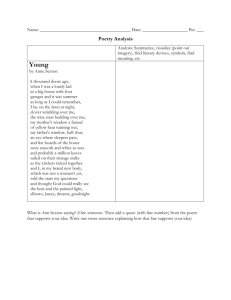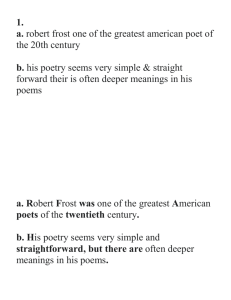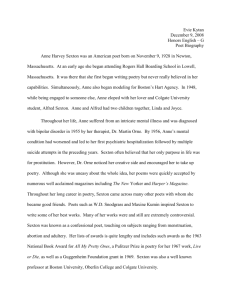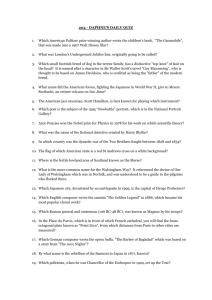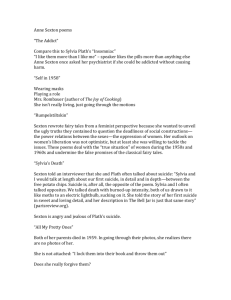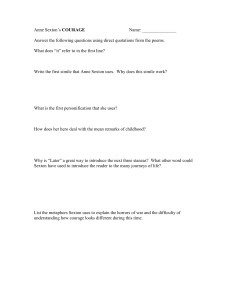anne sexton: society and the "other" woman - Acceda
advertisement
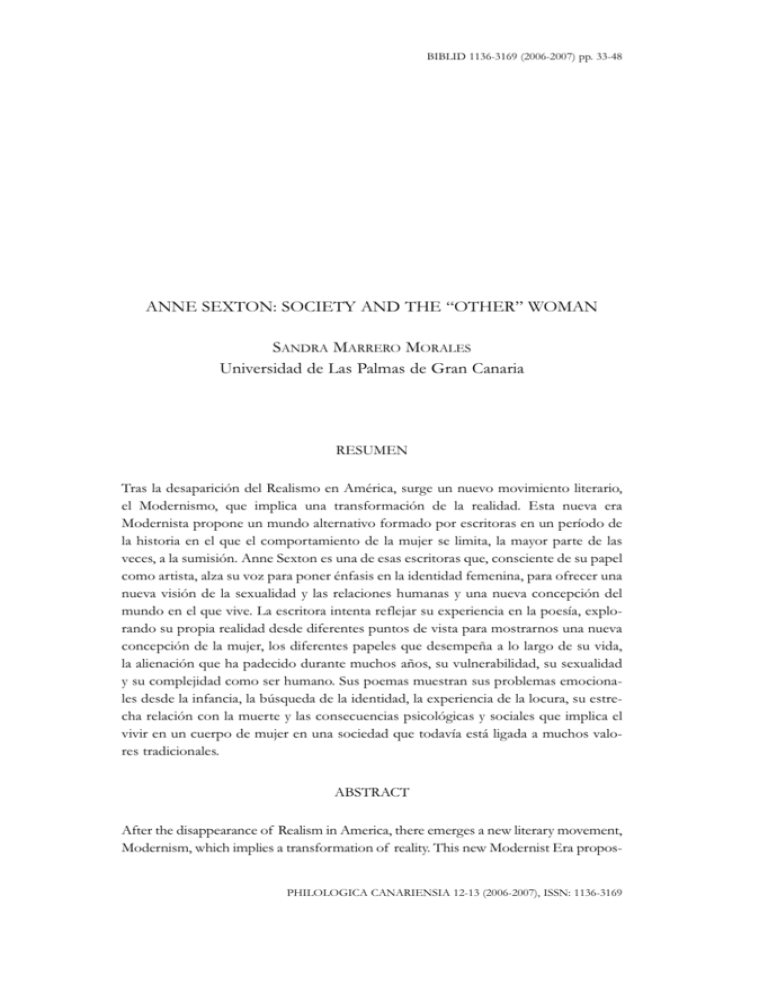
BIBLID 1136-3169 (2006-2007) pp. 33-48 ANNE SEXTON: SOCIETY AND THE “OTHER” WOMAN SANDRA MARRERO MORALES Universidad de Las Palmas de Gran Canaria RESUMEN Tras la desaparición del Realismo en América, surge un nuevo movimiento literario, el Modernismo, que implica una transformación de la realidad. Esta nueva era Modernista propone un mundo alternativo formado por escritoras en un período de la historia en el que el comportamiento de la mujer se limita, la mayor parte de las veces, a la sumisión. Anne Sexton es una de esas escritoras que, consciente de su papel como artista, alza su voz para poner énfasis en la identidad femenina, para ofrecer una nueva visión de la sexualidad y las relaciones humanas y una nueva concepción del mundo en el que vive. La escritora intenta reflejar su experiencia en la poesía, explorando su propia realidad desde diferentes puntos de vista para mostrarnos una nueva concepción de la mujer, los diferentes papeles que desempeña a lo largo de su vida, la alienación que ha padecido durante muchos años, su vulnerabilidad, su sexualidad y su complejidad como ser humano. Sus poemas muestran sus problemas emocionales desde la infancia, la búsqueda de la identidad, la experiencia de la locura, su estrecha relación con la muerte y las consecuencias psicológicas y sociales que implica el vivir en un cuerpo de mujer en una sociedad que todavía está ligada a muchos valores tradicionales. ABSTRACT After the disappearance of Realism in America, there emerges a new literary movement, Modernism, which implies a transformation of reality. This new Modernist Era propos- PHILOLOGICA CANARIENSIA 12-13 (2006-2007), ISSN: 1136-3169 [2] SANDRA MARRERO MORALES 34 es an alternative world, that of women writers, in a period of history (or herstory) in which female behaviour is, most of the time, limited to submission. Anne Sexton is one of these writers who, aware of her role as female artist, raises he voice in order to stress her female identity, offer a new vision of sexuality and human relationships and a new conception of the world in which she lives. She attempts to transmute her experience into poetry, exploring her own reality from different points of view so as to convey a new conception of the woman, the different roles she plays all along her life, the alienation that she has suffered for many years, her vulnerability, her sexuality and her complexity as a human being. Her poems show her emotional problems from childhood, the quest for identity, her experience of madness, her close relationship with death and the psychological and social consequences of inhabiting a female body, of living as a woman, in a society that is still tied to many traditional values. I will no longer be made to feel ashamed of existing. I will have my voice. I will have my serpent’s tongue, my woman’s voice, my sexual voice, my poet’s voice. (Anzaldua, 1985: 59) After the disappearance of Realism in America, there emerges a new literary movement, Modernism, which implies a transformation of the reality people are obliged to face up to. That reality is foregrounded by many international events such as the Great Depression, the 1929 New York stock market crash, the appearance of totalitarian dictatorships, the Russian Revolution and, above all, the nightmare of two World Wars. All these events are going to be portrayed by many writers, both in fiction and poetry, who attempt to reflect through their works the anguish which makes people taste the black side of life. Although many writers show a sociological background in their works, there are many others who prefer to travel to other worlds far from the hypocritical and banal attitude of the American society. The response to these international events is mostly “based on nihilistic assumptions about the world” (Gilbert & Gubar,1989: 1657). Thus, there emerges a philosophical movement, Existentialism, which posits the existence of a meaningless world inhabited by human beings who have lost the illusion of living. After the Second World War, there emerges a new generation of female writers which, like the previous one, does not accept the traditional status of women, and rebels against it raising, in this sense, the agonized outcry of their own existence in order to overcome the tradition of PHILOLOGICA CANARIENSIA 12-13 (2006-2007), ISSN: 1136-3169 [2] ANNE SEXTON: SOCIETY AND THE “OTHER” WOMAN 35 silence. Among these writers one might mention the following ones: Elizabeth Bishop, a poet interested in the close analysis of reality; Lorine Niedecker, preoccupied with the process of perception; Anne Sexton, a writer who explores the role of women in a society where she feels the alientation from herself and from other human beings; Sylvia Plath, who, like Sexton, accepts the values of her time; Denise Levertov, a poet who explores the complexities of her own character as an example of the complexity of a woman’s being, and Adrienne Rich, whose language reflects the experience of women and more concretely her own. This second literary stage is quite similar to the previous one in the sense that these writers, aware of their role as female artists, ponder over the same themes although they are approached through a much more modern attitude. These writers raise their voices in order to stress their female identity, offer a new vision of sexuality and human relationships and a new conception of the world in which they live. On the other hand, they attempt to transmute their experience into poetry, exploring their own reality from different points of view so as to convey a new conception of the woman, the different roles she plays all along her life, the alienation that she has suffered for many years, her vulnerability, her sexuality and her complexity as a human being. Let us focus our attention on a specific writer, Anne Sexton, a poet “(whose) success, like that of most writers, resulted from a combination of talent, hard work and well-timed good luck” (Colburn, 1988: 7), and more concretely on her vision of the woman in a society that has limited her role as a human being for many years. Anne Gray Harvey is born on November 9, in Weston, Massachusetts, and is educated in several public schools in Wellesley. Anne begins writing poetry when she attends Rogers Hall, a preparatory school for girls. However, her value as a poet is veiled by the fact that her mother, Mary Gray, a woman who wanted to make her daughter in her own image, accuses her of plagiarism. With the passing of time, she attends the Garland School in Boston. When finishing the school for women, she marries Alfred Muller Sexton, with whom she has two children, Linda and Joyce. In 1956 Anne suffers her first suicide attempt and is hospitalised in a psychiatric clinic where she is encouraged by her psychiatrist, Dr. Martin, to write poetry as a way of dealing with her mental PHILOLOGICA CANARIENSIA 12-13 (2006-2007), ISSN: 1136-3169 [2] SANDRA MARRERO MORALES 36 distress. According to Ben Howard, “her early poems were anguished in tone and autobiographical in content, but they were well-made, polished pieces, formally inventive and often ironic. In view of their subjects, they were remarkably reticent” (Colburn, 1988: 303). A year later, in 1957, she carries out her second suicide attempt. In September, 1958, Sexton attends Robert Lowell’s graduate writing seminar, where she meets Sylvia Plath, a writer who, like Sexton herself, “had suffered emotional deprivation as (a) young (child)” (Colburn, 1988: 30), and Kathleen Spivack, a poet who argues that “at the time we all met in Robert Lowell’s writing workshop, there was a great prejudice against women writers. This particularly referred to women who tried to combine female and poetic roles” (Colburn 1988: 35). After her second suicide attempt Anne has to be hospitalised for pneumonia, appendectomy and ovarectomy. She continues receiving psychiatric treatment, although this fact does not prevent her for committing suicide in October 4, 1974. This is the last time she tries to call the attention of the rest of the world. This last time is the definitive: Sexton, a poet who had always been obsessed with death and suffering, with madness and suicide, dies from carbon monoxide poisoning. Among Anne Sexton’s works, one might mention the following ones: To Bedlam and Part Way Back (1960), All My Pretty Ones (1962), Eggs of Things (1963), Tell Me Your Answer True (1961), Selected Poems (1964), Live or Die (1966), Love Poems (1969), Transformations (1971), The Book of Folly (1971), O Ye Tongue (1973), The Death Notebooks (1974), The Awful Rowing Toward God (1974). Furthermore, for her poetic genius she is awarded the Audience Poetry Prize for 1958-59, the Levinson Prize in November 1962, a travelling fellowship from American Academy of Arts and Letters and a Ford Foundation Grant in 1963, a travel grant from the International Congress for Cultural Freedom in 1965, the Shelley Award from the Poetry Society of America, the Pulitzer Prize for Life or Die in May 1967, the honorary Phi Beta Kappa from Harvard in June 1968 and the Guggenheim Fellowship in April 1969. Through all the works mentioned before, Sexton, a poet whose literary career began after her first suicide attempt, tries to project her inner feelings, the preoccupation with many subjects which do not only affect women PHILOLOGICA CANARIENSIA 12-13 (2006-2007), ISSN: 1136-3169 [2] ANNE SEXTON: SOCIETY AND THE “OTHER” WOMAN 37 but humankind in general, and, above all, the painful burden of her own experience. Her poems show her emotional problems from childhood, the quest for identity, her experience of madness, her close relationship with death, subjects such as abortion, menstruation, masturbation, adultery and drug addiction, which were not contemplated by previous writers, and the psychological and social consequences of inhabiting a female body, of living as a woman, in a society that is still tied to many traditional values. Anne Sexton’s vision of the woman and her relation with the society in which she lives is going to be analysed through several poems included in her work Love Poems, published in 1969, which, in Diane Wood Middlebrook’s words, “exposes the dilemma of the female poet trying to write within the conventions of the literary genre of love poetry” (Colburn, 1988: 445). “The Touch”, the poem that opens the door to Love Poems, celebrates the awakening of the woman before the arrival of love. As is already known, woman, until the beginning of the XXth Century was seen as pure and virginal, but, at the same time, she was attacked by society for her lack of passion and sexual desire. Nevertheless, in the second half of the Twentieth Century, the traditional image of the woman changes completely. She tries to attract man by making use of her sexiness and sensuality. Thus, many female writers, such as Anne Sexton, attempt to release women from the burden of tradition through poetry, focusing their attention not only on the woman’s feelings, but also on the physical side of love, trying, in this sense, to unveil the female body. The woman Sexton creates (may be Sexton herself), begins to show her body releasing her hands that have been secluded for a long time: For months my hand had been sealed off in a tiny box. Nothing was there but subway railings. Perhaps it is bruised, I thought, and that is why they have locked it up. (lines 1-4)1 The idea of alienation from the rest of the world is foregrounded by the image of the tiny box. This idea of confinement appears as a recurrent theme in Sexton’s poetry. Actually, the poet herself felt all her life the alienation and isolation that society offered her. Thus, she tried to commit PHILOLOGICA CANARIENSIA 12-13 (2006-2007), ISSN: 1136-3169 [2] SANDRA MARRERO MORALES 38 suicide several times. Perhaps, she wanted to give herself the opportunity of breaking up with all the social ties that life had imposed on her, with all the traditional morals that had prevented her from being happy. Sexton, up to this moment, has been unconscious of her own situation, has let society confine her, as if she were a pigeon, into a cage. However, although weak and vulnerable, the poet is able to find the key of her “tiny box”, that key which is able to release her hands, to make them fly to other worlds, celebrate the awakening of love. Sexton, who undervalues herself in this poem comparing her own person with a case of dog food, feels a complete alienation from her family, from her parents and sisters, from the whole of society, up to the moment in which her lover appears to rebuild those fingers that have been bruised by the passing of time, to give her a new illusion in life, the illusion of being loved: Your hand found mine Life rushed to my fingers like a blood clot. Oh, my carpenter, the fingers are rebuilt. They dance with yours. (lines 40-44) The end of the poem reveals us the intense moment between the lovers, the movements of the hands that are already free to dance in the new kingdom offered to them, the Kingdom of Love. Nevertheless, that kingdom is not contemplated by society, it does not fulfil the established moral rules and does not form part either of the traditional canons imposed by society (in later poems, we, as readers, will be able to observe that the man she refers to is married to a woman who does not know anything about the relationship of her husband with another woman. That is the reason why this is a forbidden love, a love that implies a renouncement to traditions, to many social values. However, despite this fact, this is the only thing that keeps the woman alive and happy). The second step in her relationship with her lover is revealed through “The Kiss”, a poem with which the woman recognizes her incapacity to face up to the world in solitude. Before the appearance of the lover, she spent her time crying, waiting for something or someone who could make her wake up: PHILOLOGICA CANARIENSIA 12-13 (2006-2007), ISSN: 1136-3169 [2] ANNE SEXTON: SOCIETY AND THE “OTHER” WOMAN 39 My mouth blooms like a cut I’ve been wronged all year, tedious nights, nothing but rough elbows in them and delicate boxes of Kleenex calling crybaby crybaby, you fool! (lines 1-5) Although in the second half of the Twentieth Century women claim many rights, graduate from college, have their own jobs, and want to demonstrate, furthermore, their value as human beings independent from men, Anne Sexton shows in this poem the image of a woman who is nothing without the help of the man, without his presence. The woman she creates is like a puppet handled by an uncertain fate, like a doll that needs an owner in order to live. This owner knows how to wake her “useless body”, a body that, up to that moment, has been ... a boat, quite wooden and with no business, no salt water under it and in need of some paint. It was no more than a group of boards. But you hoisted her, rigged her. (lines 11-14) Again, the writer makes reference to the same idea: the need of a physical and spiritual awakening, of something different which lets her face up to the world with another attitude, much more optimistic, and give up that fragile and valueless vision of herself. At the end of the poem, the awakening seems to have come. Before, everything was silence. Nevertheless, that silence has now turned into a heavenly melody created by a composer, the lover, who has made her body wake up with his kisses. With “The Breast” childhood gives way to the adult stage, to a new state which consists in giving and receiving pleasure. As William Shurr argues in his article “Anne Sexton’s Love Poems”, “what is perceived and repeated in each of these poems is the transition to a higher plane of being, the unfolding of a different function and a different kind of experience”. Sexton has attempted to reveal the relationship between the lovers step by step. Each poem makes reference to a different yet intense moment, of a PHILOLOGICA CANARIENSIA 12-13 (2006-2007), ISSN: 1136-3169 [2] SANDRA MARRERO MORALES 40 love affair that is not accepted by society since it does not fulfil the rules imposed by it. However, the relationship, according to William Shurr (Colburn 1988: 245), is going to continue for a long period of time: Love Poems (1969) is more than simply a collection of love poems; it is the record of a love affair which, as it is presented in the volume, lasted about four years. [...] The experience was characterized by intense moments which the lovers had together as well as frequent separations, and itfinally ended definitively. The idea of creation is again foregrounded in this poem. In “The Touch”, the lover is seen as a carpenter able to rebuild the female body whereas in “The Kiss” he is regarded as a composer who creates the sweet melody of love between them and who is, moreover, able to wake her body up. However, in this poem, “The Breast” the man appears to be the climber who has to conquer the female body: So tell me anything but track me like a climber for here is the eye, here is the jewel, here is the excitement the nipple learns. (lines 34-36) And also the architect able to mould her physical appearance: “But your hands found me like an architect” (line 12). On the other hand, the woman recognizes that her behaviour is not normal, that she is really “mad”, even imbalanced. Actually, she is being conscious of her situation, of the fact that her love affair does not fulfil the moral code of society. In spite of the fact that she is conscious of the situation, she does not do anything to finish with her love affair. She is going to continue with that love story which has filled her with happiness. “The Interrogation of the Man of Many Hearts”, a poem which follows the tradition of Medieval Love Poetry, reveals us the insistence of the woman on the reality she is living. Thus, the woman has realized that it is really true that society imposes certain rules which have to be fulfilled. Through different voices, Anne Sexton shows the opinions of both, the woman, who questions the man about his situation, and the lover, whose mind is divided into two parts: one that tries to follow the laws of society PHILOLOGICA CANARIENSIA 12-13 (2006-2007), ISSN: 1136-3169 [2] ANNE SEXTON: SOCIETY AND THE “OTHER” WOMAN 41 and one which tries to escape from tradition and accepts a relationship outside marriage. With this poem Sexton attempts to make her doubts clear and analyse the man’s behaviour towards their situation. In this sense, she realizes the importance of marriage for the woman: “These things matter to a woman” (line 15) and what implies an extramarital relationship: “(We) are not permitted to kiss on the street” (line 17). This love affair is, therefore, something forbidden by society because it does not follow the social conventions.Thus, both lovers have to hide themselves from the rest of society so as to avoid being criticized and to be able to be happy. However, that happiness is not complete since the man, who is joined to a woman through the bonds of marriage, does not think of breaking up with those ties. Marriage is something that offers him security and tranquillity, and that is the reason why it is so difficult to finish with it. The wife means everything for him: She’s my real witch, my fork, my mare, my mother of tears, my skirtful of hell, the stamp of my sorrows, the stamp of my bruises and also the children she might bear and also a private place, a body of bones that I would honestly buy, if I could buy. (lines 24-29) On the other hand, although the man is conscious of that security that marriage offers him, he does not want to renounce his lover, to whom he confesses that he is living “in torment”. Marriage has become a prison, a confinement which has reduced his freedom considerably. The idea of confinement and seclusion is seen in the poetry of many female writers of this period. For instance, Lorine Niedecker, in her poem “I Married”, ponders over marriage showing a non-romantic vision of love. She expresses the lack of communication and isolation she felt once she got married. Perhaps, she expected something different from it, something much more romantic and idilic. Denise Levertov, although she offers us a romantic vision of love in her poem “About Marriage”, she describes this stage of life as a cage of birds, as a close room in which the woman is immersed. Adrienne Rich, like Lorine Niedecker, longed for something PHILOLOGICA CANARIENSIA 12-13 (2006-2007), ISSN: 1136-3169 [2] SANDRA MARRERO MORALES 42 different once she got married. Thus, she reveals, through her poem “Aunt Jennifer’s Tigers”, the experience of women in general as regards marriage, something that has become a burden, a confinement for many women who are obliged, therefore, to follow certain rules and to fulfil the traditional role of the woman, that of being a good wife. Anne Sexton, in this sense, compares marriage to a “cot” (the wife is like a baby ) which “is almost a prison” for both husband and wife. The wife, who lives immersed in that prison, belongs, furthermore, to the husband: ...I have laid my hands upon her and have called her eyes and her mouth as mine, and also her tongue. (lines 60-62) However, the husband belongs to many other women to whom he calls “these other knots”. He recognizes that he is polygamous, that he is “a man of many hearts” and also realizes that “there is no law” to justify his behaviour. The society in which Sexton lives and which is shared, moreover, with many other female writers, such as those mentioned before, does not accept those relationships out of marriage. Each person has to fulfil, therefore, certain social rules, act with morality and sensibility and behave adequately accepting, in this sense, all those laws which are imposed by society. Nevertheless, as Sexton states in this poem, there exists no law to make a woman love a man and the reverse. “In Celebration of My Uterus” a poem which, in Mira Stark’s words, “can be viewed as (being) written in praise of Whitman’s statement (“In celebration of my body”)” (Colburn, 1988: 242) is a poem in which the writer, who identifies herself with all the women in the world, appropriates her own sexuality through language. The poet is quite innovative in the sense that she is dealing with a topic which normally does not appear in poetry. Through a colloquial language, she tries to explore the female body and celebrate the existence of the uterus. The poem, which is full of sexual connotations, tries to overcome all those stereotypes imposed by society on women. Sexton, as a woman, believes that the time of accepting her own sexuality has come and that is the reason why she sings so as to celebrate the woman she is. PHILOLOGICA CANARIENSIA 12-13 (2006-2007), ISSN: 1136-3169 [2] ANNE SEXTON: SOCIETY AND THE “OTHER” WOMAN 43 Going from the self, that identifies to the human universe, to others, to the whole world, the poet is asking society for expressing her own feelings, her points of view, her opinion as a woman: Let me carry a ten-foot scarf, Let me drum for the nineteen-year-olds, Let me carry bowls for the offering [...] Let me study the cardiovascular tissue, Let me examine the angular distance of meteors, Let me suck on the stem of flowers [...] (lines 46-52) Although in many poems written by the American poet, the body appears to be a prison, a confinement where the woman’s mind is enclosed, in this poem the writer celebrates the existence of the body and, more concretely, of the uterus, that part of the female body which contains the roots of humankind. The poet is, therefore, proud of being a woman, in spite of the fact that society imposes many rules on women. Sexton, through her poetry, criticizes, like many other writers, the situation of many women and that is the reason why she wants women to face up to it, to be conscious of their role in the society in which they live. Woman, who has played for a long time the role of “good wife” and “mother”, must be free in her actions and able to show her way of thinking. The time of escaping from the cage has come. Now, the “bird” must fly, sing and celebrate her freedom. “For My Lover, Returning to His Wife”, another poem belonging to Sexton’s work Love Poems (1969), shows, like previous poems, the problems of roles performed by women in society. Again we find the roles of husband and wife and, moreover, the role of the lover. As it was stated before, society does not accept relationships outside marriage since marriage is seen as something sacred and inviolable, as something between two people who love and understand each other. Sexton describes both the wife and the lover. The wife is described quite ironically: “She is, in fact, exquisite”(line 6), “She is all harmony” (line 15). She is, actually, the embodiment of perfection. However, that perfection is merely an invention that exists in the mind of her husband. She is, moreover, the symbol of solidity, stability and security. She is the PHILOLOGICA CANARIENSIA 12-13 (2006-2007), ISSN: 1136-3169 [2] SANDRA MARRERO MORALES 44 one who, according to the rules of society, has to take care of the children and husband and protect the family all along her life. On the other hand, the description of the lover is not so “positive”. The lover is described as something momentary which can disappear like the colours of a watercolor: Let’s face it, I have been momentary. A luxury. A bright red sloop in the harbor. My hair rising like smoke from the car window. Littleneck clams out of season. (lines 9-12) Through the roles of the wife and the lover, Anne Sexton ponders over the theme of identity of the woman. She makes reference to the incapacity of many women that, due to their marriage situation, seem to live far from the rest of the world, alienated from a society that has obliged them to follow some rules which have led them, in many cases, to unhappiness. The role of the wife in society is explored by Anne Sexton in many poems. In “Housewife”, a poem which is not included in this anthology of poems, the writer analyses the traditional role of women in society. The poem, full of ironical statements and sexual connotations, makes reference, like many other poems, to the idea of confinement. Once the woman marries the man, she feels isolated and alienated from the rest of the world. The idea of being enclosed and “protected” from the outside can be observed from the very beginning of the poem: Some women marry houses. It’s another kind of skin; it has a heart, a mouth, a liver and a bowel. (lines 1-3) Again, Sexton ponders over the traditional role of women in society. Many women, joined to a man through the bonds of marriage, are obliged to break with their past and to face up to a new life devoted to their family, their husband and children. In this sense, the woman loses her previous autonomy so as to enter a world which is different, in many PHILOLOGICA CANARIENSIA 12-13 (2006-2007), ISSN: 1136-3169 [2] ANNE SEXTON: SOCIETY AND THE “OTHER” WOMAN 45 cases, from that which she wished. Although there are many women who accept the role of wife with all its consequences, there are, on the other hand, some women who fight against the confinement that marriage supposes for them. Thus, they try to change those traditional values that, through marriage, are imposed on them to offer, therefore, a new vision of the marital state in which the woman, like the man, keeps her own identity. Therefore, the vision of marriage as a close room, as a cage in which the woman is secluded, gives way to a vision of human relationships where individual freedom to act and think is evident. In “You All Know the Story of the Other Woman”, Sexton puts on view the ephemeral character of the love affair, which is, in fact, coming to an end. The “roof ” the lovers built together is not solid and stable like that roof built by the husband and wife. It is, instead, “removable” and it can be, moreover, substituted by other “removable roofs”. Since the lover lacks the power to retain the husband, he is able to keep other relationships out of marriage and to finish with them whenever he wants to. As the poet states, “She is his selection, part time” (line 15). “The other woman” is, therefore, the lover, the poet, Anne Sexton herself, who is being conscious of her situation, of what she, as lover, means for the man. She directly addresses the reader who realizes as well that the situation she is living is not accepted by society, and that the consequences of that love affair are evident: You know the story too! Look, when it is over he places her, like a phone, back on the hook. (lines 16-18) Although society does not accept an extramarital relationship and the husband and the lover are conscious of the fact that they are not fulfilling the rules imposed by society, both go on keeping their love affair. Nevertheless, their relationship is full of doubts since the lover and the husband recognize the fact that it can be finished at some time or other. In this sense, Sexton says that she is “momentary”, ephemeral, and that she can disappear like the colours of a watercolor. Sexton, a woman who accepted all her life the values of the American society, has to fight against the world to save the love affair that filled her PHILOLOGICA CANARIENSIA 12-13 (2006-2007), ISSN: 1136-3169 [2] SANDRA MARRERO MORALES 46 with happiness for four years. Although she recognizes the fact that she broke up with those traditional rules imposed by society as regards marriage, the writer is faithful to many values of her time. Thus, she herself argues that she was “a victim of the American Dream, the bourgeois, middle-class dream. All I wanted was a little piece of life, to be married, to have children” (Colburn, 1988: 264). Being wife and mother does not prevent her from writing. She can combine quite well the role of wife and mother with that of the poet, apoet who is obsessed with death, madness, breakdowns, suicide. She attempts to enter the human heart and unveil those emotions which are fighting inside and long for coming out from the dark at some time or other. Sensitive to the human pain and obsessed with death, Anne Sexton attempts to reflect in her poetry her own emotional state, her sufferings and passions, the anguish of being deprived of maternal love when being a child. Her poetry is the poetry of the unconscious, of a world which has nothing to do with the outside world. As Alicia Ostriker quotes in his work “That Story” (Colburn, 1988: 24), [Sexton is] a strong poet of the subjective self. [...] The orientation of her poetry [is] psychoanalitic, as beffited a poet who began writing as a form of therapy following mental breakdown, who enact(s) in her poems the analysand’s self-probing through examination of relationships with others and who explain(s) the vitality of their images by saying that “poetry, after all milks the unconscious”. Thus, the world reflected by Anne Sexton on her poetry is the world of the heart, of emotions, of suffering, of a society which attempts, by all means, to change the vision of those moral values through the experience of a writer who ponders over the traditional role of the woman. Anne Sexton is, in fact, one of those women who recognize their role as victims of a society who live, moreover, through the lines of the poetry of a poet who is seen by Robert Lowell “as having the large transparent, breakable, and increasingly ragged wings of a dragonfly”. PHILOLOGICA CANARIENSIA 12-13 (2006-2007), ISSN: 1136-3169 [2] ANNE SEXTON: SOCIETY AND THE “OTHER” WOMAN 47 NOTAS 1 All the quotations have been taken from Gilbert, Sandra & S. Gubar. 1989. The Norton Anthology of Literature by Women. London: W. W. Norton & Company. WORKS CITED ANZALDUA, G. Borderlands. La Frontera. The New Mestiza. San Francisco: Spinster/Aunt Lute, 1985. COLBURN, S. E. (ed). Anne Sexton. Telling The Tale. Michigan: The University of Michigan Press, 1988. GILBERT, S. & S. GUBAR. The Norton Anthology of Literature by Women. London: W. W. Norton & Company, 1989. SEXTON, A. Love Poems. Boston: Houghton Mifflin Company, 1969. PHILOLOGICA CANARIENSIA 12-13 (2006-2007), ISSN: 1136-3169
